Yet another isolated incident: blackface at Stetson University
Here's a pretty old legacy post from the blog archives of Geekery Today; it was written about 20 years ago, in 2005, on the World Wide Web.
(I found out about this from Pam Spaulding at Pandagon [2005-11-27].)
Campus life in America
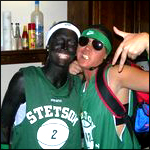
Stetson University, Halloween 2005
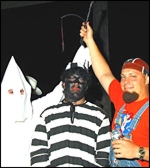
Oklahoma State, September 2002
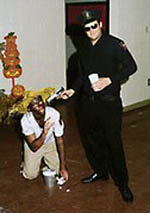
Ole Miss, Halloween 2001.
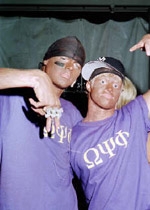
Auburn, Halloween 2001.
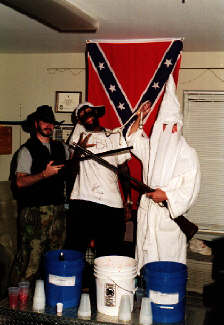
Auburn, Halloween 2001.
This Halloween, the (mostly white) women’s softball team at Stetson University in Florida decided to live it up by dressing as the (mostly Black) women’s basketball team for an off-campus Halloween party. Some of the nice little details that they decided to add to their costume included: gold teeth, corn rows, thug
poses for photos. Oh, and also blackface makeup.
We’re told by a student from the campus who knows them that I do not think the girls were trying to be racist; I honestly believe that they do not understand what they did.
That’s probably true. It’s also very sad. Fortunately, though, careless ignorance of recent American history and blackface fun-and-games at college Halloween parties aren’t at all pervasive or common among affluent white college students. This is, of course, just an isolated incident; it’s not like there is any kind of festering racism in the American campus culture at all. Nothing to see here, citizen; move along.
Completely unrelated links
- Tolerance.org 2002-09-25: Jim Crow
Bizarre
at OK State - GT 2002-05-13: Here we go again – frat racism ad Syracuse
- GT 2001-11-14: And the other shoe drops – Delta Sigma Phi dissolved in frat racism scandal
- GT 2001-11-14: One down, one to go… – Beta Theta Pi dissolved in frat racism scandal
- GT 2001-11-09: The Context of racism at Auburn fraternities
- Tolerance.org (2001-11-08): University of Mississippi Fraternity Suspended Until 2002
- GT 2001-11-06: Virulent racism at Auburn fraternities
- Tolerance.org (2001-11-19): Hate in the News List of Campus Incidents
Historical note, free of facile sarcasm
I don’t just say this because I know people in the Auburn fraternity system who are not the sloped-brow, amoral, reactionary meatheads that the Greeks’ history on Auburn’s campus might lead you to believe they would have to be–although this is definitely true; I have friends in the fraternity system who neither have nor want any part of that mindset. I also say it because I really regret that the meatheads that were directly involved will probably never understand just what they did wrong. They will understand that they did some dumb things that got them caught. And they may look back and grumble at the P.C. Thought Police Bastards who ruined their college career. But will they ever understand that there really was a very deep cut of wilful cruelty in what they did? They didn’t put on those costumes in order to be malicious racists (although I believe that there was certainly some overt malice involved). They put them on to have a roguish bit of fun, that old irreverant frat boy panache. Meaningless images of MTV gangstas and some documentary on the Klan they saw in school or on the History channel–trivial, ultimately, like the whole flux of images across our consciousness. Anything can be funny, right? If you don’t really go out and attack Black people, the images don’t mean anything, do they?
But words, images, costumes, historical scripts do mean something; they mean a hell of a lot. The images and rituals, the signs of white supremacist brutality in this country have a meaning, a meaning they are rooted to by centuries of blood and chains. But we live in an age in which the detached image and the spectacle is omnipresent, and yet the prevailing laid-back liberal ideology tells us that we have no reason to care, indeed, that if we do care it’s a sign of pretentiousness, humorlessness, a general need to lighten the hell up. And it’s slowly, surely killing our conscience, eating away at the possibility of being moral agents. Which has what to do with frat boys in Klan robes? I really fear that this soul-killing laid-back liberalism, the impetus behind the costumes in the first place, will also cripple the boys at Beta and Delta Sig from ever understanding what they did wrong, the cutting cruelty that they were willing to ignore in order to have a laugh. Just as much as their hate party outrages me against them, what it means also saddens me for them.
The worst part about it all are the smiles. The goofy, clueless, happy-go-lucky grins of white college students who don’t understand a goddamned thing about what they’re doing, and just don’t care.
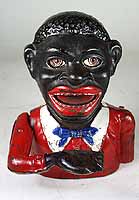
This is a picture of a Jolly Nigger Bank. During the 1880s these were a remarkably popular mechanical bank for children; place a coin on the black man’s hand and he pops it into his mouth as his bug-eyes roll back into his head. the Jolly Nigger Bank was just one of hundreds of popular children’s toys, during the late 19th and early 20th centuries, that used grotesque caricatures of Black people, based on the images and conventions of blackface minstrel shows. It’s hard to believe, today, how pervasive these images were: they were everywhere, not just in children’s toys but also staples of the most popular forms of music and theater, film, cartoons, even advertising brands for everything from pancake mix to washing powder. Blackface caricatures surged in popularity in the decades after Reconstruction, and continued well into the 1940s before the rise of the Civil Rights movement in the 1950s and 1960s did it in. Blackface imagery was a pervasive feature of American pop culture for over a century, a feature intimately connected with casual racism, militant white supremacy, lynch law, race riots, and Jim Crow (you may recall that the system of segregation was itself named after America’s first known minstrel show stock character.
Now, there are two different ways that horrible things can end in the wake of coordinated cultural pressure. The privileged can remember them, and take responsibility for them, as hateful reminders of a shameful past. Or the privileged can do their best to pretend that they never existed, avoid mentioning them for fear of giving offense, drop them down the memory hole in the name of propriety, and drive them into the cultural underground rather than addressing them in the daylight.
Affluent whites in America — that same college-educated professional class that we daily hear praising itself and berating the redneck,
reactionary
white working class — decided to do the latter, not the former, with blackface when Black people made it clear that they weren’t going to stand for it anymore. Down the memory hole they sent it, and they taught that response — by not teaching that history — to their kids. You are seeing the affects of that decision on white college kids’ consciousness with every passing school year.
I am so tired of “they didn’t know” or “they didn’t mean anything by it.” If these girls are so ignorant of the problems of African Americans in their own country, what the hell are they doing in a university? That is mighty ignorant–too ignorant for an institution of higher learning.